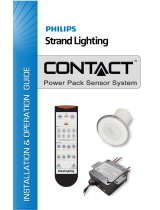
72-00538, Rev. E
WASP Occupancy Sensors
INSTALLATION INSTRUCTIONS
Page 4 of 5
Rev 06/09/22
2101B_WASP_Install
currentlighting.com
© 2022 HLI Solutions, Inc. All rights reserved. Information and specifications subject to change
without notice. All values are design or typical values when measured under laboratory conditions.
SWITCHES 5 & 6 PRIMARY TIMER: Controls time interval to turn o light(s) controlled by Primary Timer after the
lighted space becomes unoccupied. Available settings are 8, 4, 16, and 30 minutes. Default: 8 minutes (Switches 5 & 6 –
OFF Position)
SWITCHES 7 & 8 SECONDARY TIMER: Used on dual relay sensors only. Controls time interval to turn o light(s) controlled
by Secondary Timer after the lighted space becomes unoccupied. Available settings are DISABLED (Secondary lights switch
o with Primary), 30, 60, and 90 minutes. Default: DISABLED (Switches 7 & 8 – OFF Position).
SWITCHES 9, 10, 11 & 12 DAYLIGHT SENSOR SET POINT LEVELS:
Enables or disables daylight sensor operation. When enabled, the sensor turns lights on in response to occupancy when
light levels are below the daylight sensor set point – set by Switches 9-12. Daylight sensor setting should be set to a value
that turns o articial lighting when natural light levels reach the designed light levels at task. To determine this value,
light level measurements should be taken when the natural light levels are at their highest peak (typically between 10am
– 2pm). With articial lighting on, measure the light level at the task area. When the measurement at task level is twice the design level, measure the light level
at the sensor. NOTE: light meter should be oriented in the same direction as the selected upward or downward looking daylight sensor. Congure switches 9-12 to the
value closet to the meter’s reading. Default: Disabled (Switches 9-12 – OFF Position.
Sensor operation when daylight sensor is disabled:
• Single Output Sensor – Occupancy controlled.
• Dual Output Sensor – Output 1 & Output 2: Occupancy controlled. Smart Cycling and Leave On Mode function as normal.
Sensor operation when daylight sensor is enabled:
• Single Output Sensor - Occupancy controlled with daylighting override.
• Dual Output Sensor – Output 1: Occupancy controlled with daylighting override; Output 2: Occupancy controlled. NOTE: If Smart Cycling is enabled,
the daylighting override will stay with the ‘Primary’ relay which will switch back and forth between the output channels. If Smart Cycling is disabled,
daylighting override will remain with Output 1. Daylighting override can be assigned to Output 2 by disabling Smart Cycling, enabling Leave On Mode
and by setting the Secondary Timer to anything other than DISABLED.
UPW ARD LO O KIN G DO W N WA R D LO O KIN G
Set Point Levels Dead Band Switch 9 Switch 10 Switch 11 Switch 12 Set Point Levels Dead Band Switch 9 Switch 10 Switch 11 Switch 12
Sensor Disabled N/A OFF OFF OFF OFF Sensor Disabled N/A OFF OFF OFF OFF
2500 FC 20% OFF OFF OFF ON 100 FC 20% OFF OFF OFF ON
2000 FC 20% OFF OFF ON OFF 75 FC 20% OFF OFF ON OFF
1800 FC 20% OFF OFF ON ON 50 FC 20% OFF OFF ON ON
1400 FC 20% OFF ON OFF OFF 25 FC 20% OFF ON OFF OFF
1000 FC 20% OFF ON OFF ON 20 FC 20% OFF ON OFF ON
800 FC 20% OFF ON ON OFF 15 FC 20% OFF ON ON OFF
600 FC 20% OFF ON ON ON 12.5 FC 20% OFF ON ON ON
400 FC 20% ON OFF OFF OFF 10 FC 20% ON OFF OFF OFF
300 FC 20% ON OFF OFF ON 8 FC 20% ON OFF OFF ON
250 FC 20% ON OFF ON OFF 7 FC 20% ON OFF ON OFF
200 FC 20% ON OFF ON ON 6 FC 20% ON OFF ON ON
150 FC 20% ON ON OFF OFF 5 FC 20% ON ON OFF OFF
100 FC 20% ON ON OFF ON 4FC 25% ON ON OFF ON
50 FC 20% ON ON ON OFF 3 FC 33% ON ON ON OFF
30 FC 20% ON ON ON ON 1 FC 50% ON ON ON ON
Note: Dead band is factory set. To prevent unwanted cycling, the light level at the sensor face must exceed the FC set point by the amount of dead band before the lights will
turn o. Conversely, the light level must drop below the set point plus the dead band before the lights will turn on.
SWITCH SETTINGS FOR DISABLING ALL SENSOR FUNCTIONALITY
In order to disable all sensor functionality, set DIP switches to the following positions. Note: switch settings apply to all WASP2 models, including single relay versions
that do not use switches 7 and 8 in normal operation. If sensor functionality does not need to be disabled, refer to switch settings guide above.
Switch 2 – Smart Cycling: ON
Switch 3 – Leave On: ON
Switch 7 – Secondary Timer: ON
Switch 8 – Secondary Timer: ON
Primary Switch 5 Switch 6
8 Mins OFF OFF
4 Mins OFF ON
16 Mins ON OFF
30 Mins ON ON
Secondary Switch 7 Switch 8
Disabled OFF OFF
30 Mins OFF ON
60 Mins ON OFF
90 Mins ON ON








